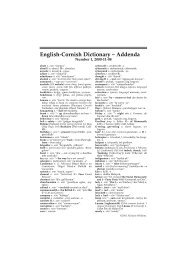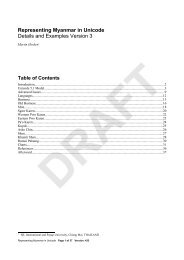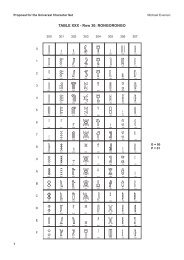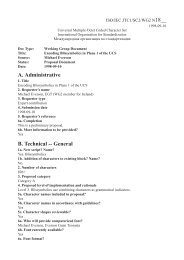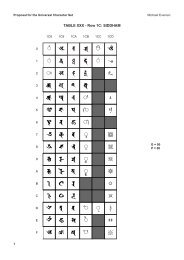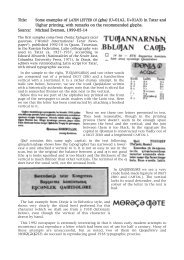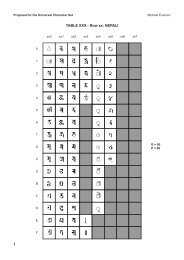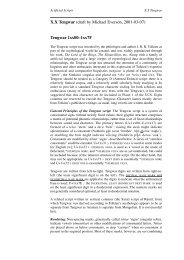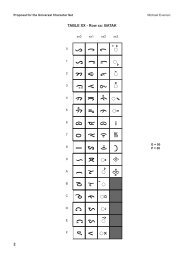Final text for Latin/Greek alphabet TITLE PAGE - Evertype
Final text for Latin/Greek alphabet TITLE PAGE - Evertype
Final text for Latin/Greek alphabet TITLE PAGE - Evertype
Create successful ePaper yourself
Turn your PDF publications into a flip-book with our unique Google optimized e-Paper software.
© ISO/IEC ISO/IEC 8859-7:2003 (E)<br />
Foreword<br />
ISO (the International Organization <strong>for</strong> Standardization) and IEC (the<br />
International Electrotechnical Commission) <strong>for</strong>m the specialized system<br />
<strong>for</strong> worldwide standardization. National bodies that are members of ISO or<br />
IEC participate in the development of International Standards through<br />
technical committees established by the respective organization to deal<br />
with particular fields of technical activity. ISO and IEC technical<br />
committees collaborate in fields of mutual interest. Other international<br />
organizations, governmental and nongovernmental, in liaison with ISO<br />
and IEC, also take part in the work.<br />
In the field of in<strong>for</strong>mation technology, ISO and IEC have established a<br />
joint technical committee, ISO/IEC JTC1. Draft International Standards<br />
adopted by the joint technical committee are circulated to the member<br />
bodies <strong>for</strong> voting. Publication as an International Standard requires<br />
approval by at least 75% of the national bodies casting a vote.<br />
International Standard ISO/IEC 8859-7 was prepared by Joint Technical<br />
Committee ISO/IEC JTC1, In<strong>for</strong>mation technology, Subcommittee SC2,<br />
Coded character sets.<br />
This edition cancels and replaces ISO 8859-7:1987 which has been<br />
technically revised.<br />
ISO/IEC 8859 consists of the following parts, under the general title<br />
In<strong>for</strong>mation technology – 8-bit single-byte coded graphic character sets:<br />
– Part 1: <strong>Latin</strong> <strong>alphabet</strong> No. 1<br />
– Part 2: <strong>Latin</strong> <strong>alphabet</strong> No. 2<br />
– Part 3: <strong>Latin</strong> <strong>alphabet</strong> No. 3<br />
– Part 4: <strong>Latin</strong> <strong>alphabet</strong> No. 4<br />
– Part 5: <strong>Latin</strong>/Cyrillic <strong>alphabet</strong><br />
– Part 6: <strong>Latin</strong>/Arabic <strong>alphabet</strong><br />
– Part 7: <strong>Latin</strong>/<strong>Greek</strong> <strong>alphabet</strong><br />
– Part 8: <strong>Latin</strong>/Hebrew <strong>alphabet</strong><br />
– Part 9: <strong>Latin</strong> <strong>alphabet</strong> No. 5<br />
– Part 10: <strong>Latin</strong> <strong>alphabet</strong> No. 6<br />
– Part 11: <strong>Latin</strong>/Thai <strong>alphabet</strong><br />
– Part 12: (unassigned)<br />
– Part 13: <strong>Latin</strong> <strong>alphabet</strong> No. 7<br />
– Part 14: <strong>Latin</strong> <strong>alphabet</strong> No. 8 (Celtic)<br />
– Part 15: <strong>Latin</strong> <strong>alphabet</strong> No. 9<br />
– Part 16: <strong>Latin</strong> <strong>alphabet</strong> No. 10<br />
Annexes A, B, and C of this part of ISO/IEC 8859 are <strong>for</strong> in<strong>for</strong>mation only.<br />
iii





